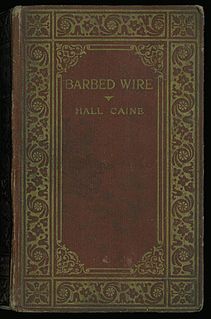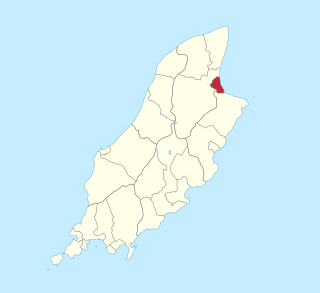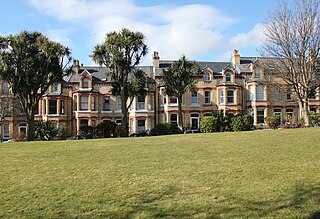Gerhard Bersu was a German archaeologist who excavated widely across Europe. He was forced into exile from Germany in 1937 due to anti-Semitic laws in pre-war Nazi Germany. He was interned on the Isle of Man during World War II where he made several significant archaeological discoveries such as the Viking boat burial at Balladoole.

The Poston Internment Camp, located in Yuma County in southwestern Arizona, was the largest of the ten American concentration camps operated by the War Relocation Authority during World War II.
A civilian internee is a civilian detained by a party to a war for security reasons. Internees are usually forced to reside in internment camps. Historical examples include Japanese American internment and internment of German Americans in the United States during World War II. Japan interned 130,000 Dutch, British, and American civilians in Asia during World War II.
Ilag is an abbreviation of the German word Internierungslager. They were internment camps established by the German Army in World War II to hold Allied civilians, caught in areas that were occupied by the German Army. They included United States citizens caught in Europe by surprise when war was declared in December 1941 and citizens of the British Commonwealth caught in areas engulfed by the Blitzkrieg.
Dame Joanna Margaret Cruickshank, was a British military nurse and nursing administrator. She founded Princess Mary's Royal Air Force Nursing Service in November 1918 and served as its first Matron-in-Chief from 1921 until her retirement in November 1930.

Stanley Internment Camp was a civilian internment camp in Hong Kong during the Second World War. Located in Stanley, on the southern end of Hong Kong Island, it was used by the Japanese imperial forces to hold non-Chinese enemy nationals after their victory in the Battle of Hong Kong, a battle in the Pacific campaign of the Second World War. About 2,800 men, women, and children were held at the non-segregated camp for 44 months from early January 1942 to August 1945 when Japanese forces surrendered. The camp area consisted of St Stephen's College and the grounds of Stanley Prison, excluding the prison itself.
Kenichi Zenimura was a Japanese-American baseball player, manager, and promoter. He had a long career with semiprofessional Japanese-American baseball leagues in the western United States and Hawaii; these leagues were very active and popular from about 1900 to 1941. He is also noted for the successful barnstorming tours he organized that brought famed players such as Babe Ruth and Lou Gehrig to the west coast and to Japan for exhibition games in the 1920s and 1930s. Along with most Japanese-Americans living on the west coast of the United States, during World War II he was incarcerated with his family in an internment camp. Their camp was the Gila River War Relocation Center in Arizona. There he led construction of a complete baseball field including spectator stands, and he organized baseball leagues for the internees. These leagues were important both to the morale of the internees and to building relationships with nearby Arizona residents. Zenimura has been called the "Father of Japanese American Baseball".
Yasutaro (Keiho) Soga was a Hawaiian Issei journalist, poet and activist. He was a community leader among Hawaii's Japanese residents, serving as chief editor of the Nippu Jiji, then the largest Japanese-language newspaper in Hawaii and the mainland United States, and organizing efforts to foster positive Japan-U.S. relations and address discriminatory legislation, labor rights and other issues facing Japanese Americans. An accomplished news writer and tanka poet before the war, during his time in camp Soga authored one of the earliest memoirs of the wartime detention of Japanese Americans, Tessaku Seikatsu or Life Behind Barbed Wire.
Italian Canadian internment was the removal and internment of Italian Canadians during World War II following Italy's June 10, 1940, declaration of war against the United Kingdom. Through the War Measures Act, the government of Canadian Prime Minister William Lyon Mackenzie King gave itself the power to suspend habeas corpus, revoke rights, seize property and arrest those who were deemed a threat to the safety of Canada—labelling 31,000 Italian Canadians as "enemy aliens". Between 1940 and 1943, between 600 and 700 Italian Canadian men were arrested and sent to internment camps as potentially dangerous "enemy aliens" with alleged fascist connections. In the decades that followed, political apologies were made for the internment of Italian Canadians.

The Woman of Knockaloe: A Parable is a melodramatic novel by Hall Caine first published in 1923. Set on the Isle of Man during the First World War, a young woman finds herself drawn to one of the nearby German internees. They begin a romance in the face of the fierce hostility of the local community which eventually drives them to commit suicide. The story has been described as a "minor masterpiece".
The Metropole Internment Camp was a World War II internment camp in Douglas, Isle of Man. Officially known as “S” Camp, it was predominantly for Italians and was in existence from July 1940 until November 1944.

Mooragh Camp was a World War II internment camp in Ramsey, Isle of Man, in operation from May 1940 until September 1945. It was the first such camp on the island since World War I.

Hutchinson Internment Camp was a World War II internment camp in Douglas, Isle of Man, particularly noted as "the artists' camp" due to the thriving artistic and intellectual life of its internees.

On direct instructions from Adolf Hitler, and in breach of both International Law and the terms of surrender signed in July 1940, Nazi German forces deported and interned 2,300 Channel Island civilian residents who had committed no crimes. The stated reason was retaliation for internment of German citizens in Persia by the British Government.
Italian prisoners of war in Australia were Italian soldiers captured by the British and Allied Forces in World War II and taken to Australia.
Port Erin Women's Detention Camp was a World War II internment camp on the Isle of Man at Port Erin. It was Europe's only all-female internment camp. Notable internees included Dora Diamant the lover of Franz Kafka in the last year of his life, and Fay Taylour, champion motorcycle, speedway and racing car driver.
The Empty Chair Memorial is a memorial located at Capital School Park in downtown Juneau, Alaska, United States. It is dedicated to the 53 Juneau residents of Japanese origin who were forcibly relocated and imprisoned in inland internment camps during World War II, as well as to recognize Juneau citizens for their helpful response when the families returned after the war. It is the first memorial in Alaska regarding the internment of Japanese Americans during the war.

The history of the Jews in the Isle of Man goes back to at least the early 19th century.

Chapel Hill, Balladoole is a significant historical and archaeological site in Arbory on the Isle of Man. The site is a short distance from Castletown in the south of the Island. It is located on a small hilltop overlooking the coast. Balladoole has undergone extensive archaeological excavations in the 20th century, most notably in 1944-1945 by German archaeologist Gerhard Bersu who was interned on the Isle of Man during World War II.








